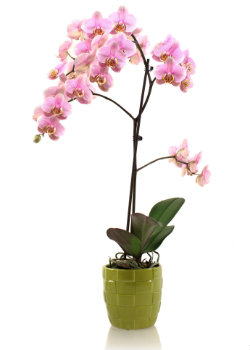
Water — it’s essential for life. It can also be a source of confusion for many orchid growers because, unlike other houseplants, orchids don’t require the daily watering many plant owners are used to—just three ice cubes or a ¼ cup of water for a full-size orchid, or one ice cube or 1½ tablespoons for a mini orchid weekly.
With our busy schedules, it can be easy to forget when you last watered your orchid, leaving it susceptible to the effects of too much or too little hydration. The good news is all you need is your eyes to tell if your orchid needs more or less water.
Healthy Phalaenopsis orchid leaves should be green, firm and waxy. If your orchid’s leaves look less than perky, it’s a sign it needs more water.
As the description would suggest, this is another sign of underwatering.
What to do: Before you grab some extra ice or water, stop. Rehydrating your orchid is as simple as getting back to its normal watering schedule—which means using either three ice cubes or one ice cube depending on the size of your orchid. (Is your calendar already full? There’s a watering reminder for that.)
Forgetfulness isn’t the only reason your orchid could be drier than usual. Check where you’ve placed it and make sure it is not in the path of any drafts or air from vents. If you find your orchid is the victim of dry air, move it out of the path of the draft or vent and resume its watering schedule.
If you get back on a regular watering schedule and your orchid isn’t in the path of drafts but it’s still dry, head to your sink with a small bucket. Fill the bucket with just enough water to cover the top of the plant's container and soak your orchid’s bark and roots for two minutes. Once your orchid has soaked, allow it to thoroughly drain, put it back in its pot and resume its normal watering schedule.
Soft and yellow leaves can also be a sign your orchid is getting too much water.
If your orchid is otherwise healthy on inspection, but you’re losing buds, it could be because it has been overwatered.
What to do: This is where your powers of inspection come in handy. Take your orchid out of its pot and look at the roots. Are they brown or black and squishy-looking? This is one of the most common signs of orchid overwatering. Grab a pair sterilized scissors and brush away parts of the potting media to get a really close look at the roots. Use the scissors to cut away the damaged parts of the roots at least a quarter of the way into the healthy portion. (Remember, healthy roots are plump and green.)
Now, turn your attention to the pot. Drain any excess water from the bottom and rinse it out. Then repot your orchid. However, if you notice there are no healthy areas of root left, it may be time to discard the plant and replace it with a new, healthy one.
It’s easy to see why Phalaenopsis orchids are so popular—their care routines are very simple, and in most cases if they are dry or overwatered, it is fairly simple to remedy. By knowing what to look for and inspecting your orchid’s roots, you can help ensure your plant will provide you with beautiful blooms for months and years to come. Get everything you need to know about caring for your orchid — from bringing it home, to fertilizing it, to repotting and more — in our orchid care guide.

Copyright Just Add Ice® Orchids 2023